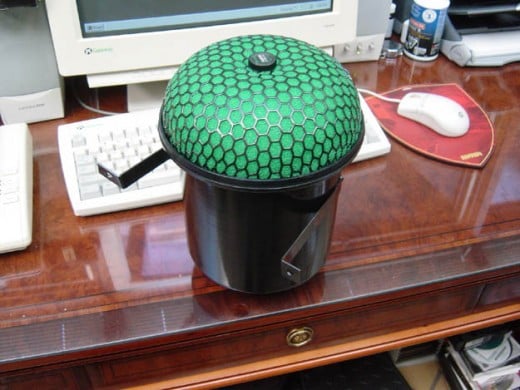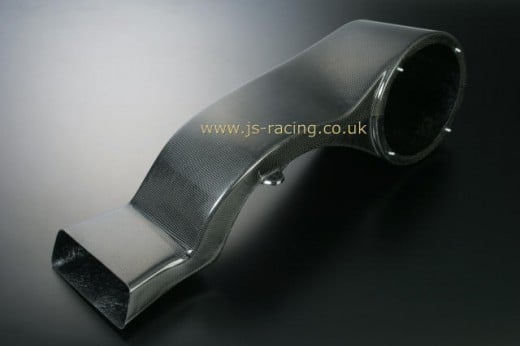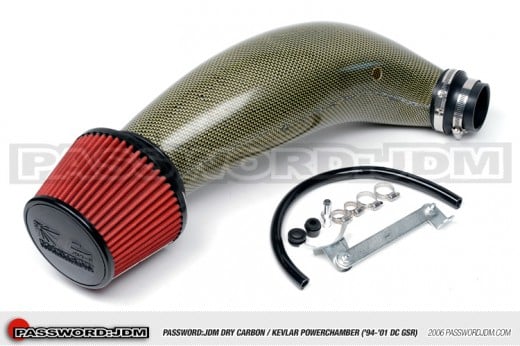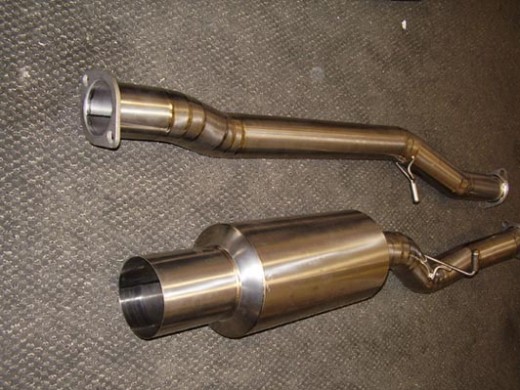cold air intakes
The idea behind cold air intakes
Cold air intakes (CAI's) were designed for the purpose of grabbing the coldest air possible to flow into the engine. Generally, a CAI will consist of a length of either metal or plastic tubing, with a filter on the end. How long the tubing is depends on the vehicle application. Some cars require a CAI to snake past various components. The further the filter is from the engine compartment, the colder the air will be. Placing the filter away from the hot engine compartment will allow the engine to intake colder air, which is more dense. Dense air allows for more power. About the only downside to a cold air intake is the possibility of hydrolocking an engine.
Hydrolocking occurs when the engine intakes water instead of air - Which can happen if you drive through a puddle deep enough to submerge the air filter. Intaking water wouldn't be such a bad thing, except water can not be compressed. Hydrolic systems (like the one that operates the brakes in your car) work on the concept that liquids will not compress. If you put force on the liquid, it had better have somewhere to go. In the event of hydrolocking an engine, the water is trapped in the cylinders of the engine. The piston comes up, but the water won't compress, and it has no where to go, but the crank, connecting rods, and pistons don't care. The piston will continue in its valiant attempt to reach top dead center (TDC). Connecting rods will be bent, pistons will weep, and your wallet will beat the crap out of you.
Many cold air intake manufacturers will often supply different types of filters and bypass systems on their intakes to prevent hydrolocking, however, it's been argued that they won't work when your engine is sucking in 100% water. If you're fortinute enough to live someplace where its sunny for 90% of the year, then by all means, get the cold air intake you want. If you live where it rains 90% of the year, don't risk your engine for a few extra horsepower. Buy a short ram intake (SRI) instead. They generally make less power as the air filter remains close to the engine, but they'll still add a bit of grunt to most cars.
The science of an air intake
Many people assume that all cold air intake systems will function the same way. They suck in air, the engine adds some much needed fuel, fires a happy little spark plug, and then converts the ensuing chemical enegry into mechanical energy. But alas, this is not the case.
Original Equiptment Manufacturers (OEM's) design their air intake systems to be quiet. They quiet the air intake by using small-diameter tubing, small airflow impeding baffles, and by using low-restriction air filters. The aftermarket companies who produce cold air intakes will often do the following to increase the airflow of the intake system.
- Increase the diameter of the tubing, which allows increased flow.
- Smoothing the inner piping of the intake, reducing restrictions.
- Providing more direct routes to the throttle body.
- Using specific lengths of intake tubing in order to create more power in different specific engine speeds.
- Utilizing high-flow, high-filtering air filters.
Intakes have been made out of nearly countless amounts of materials. OEM intakes are cheap and easy to mass produce, and are often made of a rubber (silicone) material. Aftermarket air intakes are often more expensive to produce, and as such generally cost a bit more than what you would pay for an OEM replacement. The most common materials used in aftermarket intakes are:
- Plastic
- Metal
- Rubber
- Fiberglass
- Carbon Fiber
- Kevlar
Since the air spends a very small ammount of time actually in the piping before entering the cylinder head, the type of material used often will not make a difference in the temperature of the intake air.
The use of lightweight metals like aluminum, and even titanium in very exotic applications, is generally done for the weight-saving properties of the materials themselves, rather than for the temperature of the intake air. The same can be said for composite intakes like fiber glass, carbon fiber and kevlar.
The air filter itself is arguably the most imporant part of an intake system. The air filter must allow enough airflow to keep the engine operating effectively and efficiently. At the same time, the air filter must also filter out dirt and dust particles that are harmful to an engine. There are two types of materials used in air filters. Both have their positives and their negatives. Below you'll see the two types of filters, as well as a list of their pro's and con's.

Foam Filter Elements
Many aftermarket companies, particularly those in from Japan, utilize foam filter elements. Foam filter's have been known to flow a little bit more air than pleated paper filters, but by a very marginal amount. Studies done on a message board by a member showed that the difference was akin to that of about one horsepower. The downside to foam based filters, is that they allow more dirt and dust into the intake tract, which can never be a good thing.
Pleated Paper Filters
Pleated paper air filters flow slightly less than foam-based filters, but filter far more dust and other nasty debris. At the end of the day, from my personal experience, I would use a pleated paper filter on a reguarly driven street car, and a foam filter on a dedicated race car, where having one or two extra horsepower can mean the difference between winning or losing.
Exotic material based intake systems
Several companies, based in both Japan and the United States, offer carbon fiber and kevlar based intake systems. Companies like J's Racing in Japan, and Password JDM in the United States. Quality varies, but for the most part, is high enough that the intake will last for a long time. Below are some examples of composite fiber based intakes.

Carbon fiber intakes
Carbon intakes offer light weight advantages. It can also be said that in certain applications, carbon will also help to isolate the intake air from the outside air, allowing the air to remain as cold as possible.

Kevlar Intakes
Kevlar based intakes are similar to carbon intakes in that they don't weigh much. It could be argued that only the most extreme race car could benifit from the minute weight savings a kevlar intake could offer, but the kevlar based systems also hold a certain ammount of aesthetic appeal.

Titanium Tubing
How rare are titanium intake systems? Rare enough that I couldn't find a picture of one. Titanium is one of the most exotic, and expensive metals around. It offers great strength, and a rediculously low weight. Titanium intake and exhaust systems generally feature extremely thin walls, often about 1mm thick, for even more extreme weight savings.



